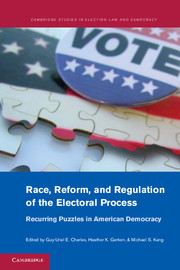Book contents
- Frontmatter
- Contents
- Figures
- Tables
- Contributors
- Preface
- Introduction: The Future of Elections Scholarship
- PART I RACE AND POLITICS
- Overview: How, If at All, Is Racial and Ethnic Stratification Changing, and What Should We Do about It?
- 1 Voting Rights
- 2 The Reconstruction of Voting Rights
- 3 Explaining Perceptions of Competitive Threat in a Multiracial Context
- PART II COURTS AND THE REGULATION OF THE ELECTORAL PROCESS
- PART III ELECTION PERFORMANCE AND REFORM
- PART IV CONCLUSION
- Index
2 - The Reconstruction of Voting Rights
Published online by Cambridge University Press: 01 June 2011
- Frontmatter
- Contents
- Figures
- Tables
- Contributors
- Preface
- Introduction: The Future of Elections Scholarship
- PART I RACE AND POLITICS
- Overview: How, If at All, Is Racial and Ethnic Stratification Changing, and What Should We Do about It?
- 1 Voting Rights
- 2 The Reconstruction of Voting Rights
- 3 Explaining Perceptions of Competitive Threat in a Multiracial Context
- PART II COURTS AND THE REGULATION OF THE ELECTORAL PROCESS
- PART III ELECTION PERFORMANCE AND REFORM
- PART IV CONCLUSION
- Index
Summary
In 1883, in the Civil Rights Cases, the Supreme Court wrote:
When a man has emerged from slavery, and by the aid of beneficent legislation has shaken off the inseparable concomitants of that state, there must be some stage in the progress of his elevation when he takes the rank of a mere citizen, and ceases to be the special favorite of the laws, and when his rights as a citizen, or a man, are to be protected in the ordinary modes by which other men's rights are protected.
The distinction between “special favoritism” and the “ordinary modes” of rights protection is a recurring question in American constitutional law. Consider just two recent examples: In Romer v. Evans, the Supreme Court confronted a Colorado initiative (“Amendment 2”) that foreclosed the adoption of antidiscrimination provisions that would forbid discrimination on the basis of sexual orientation. Colorado defended the enactment on the grounds that it did nothing more than deny “special rights” to gay people. The Supreme Court rejected that argument:
We find nothing special in the protections Amendment 2 withholds. These are protections taken for granted by most people either because they already have them or do not need them; these are protections against exclusion from an almost limitless number of transactions and endeavors that constitute ordinary civic life in a free society.
- Type
- Chapter
- Information
- Race, Reform, and Regulation of the Electoral ProcessRecurring Puzzles in American Democracy, pp. 34 - 51Publisher: Cambridge University PressPrint publication year: 2011



